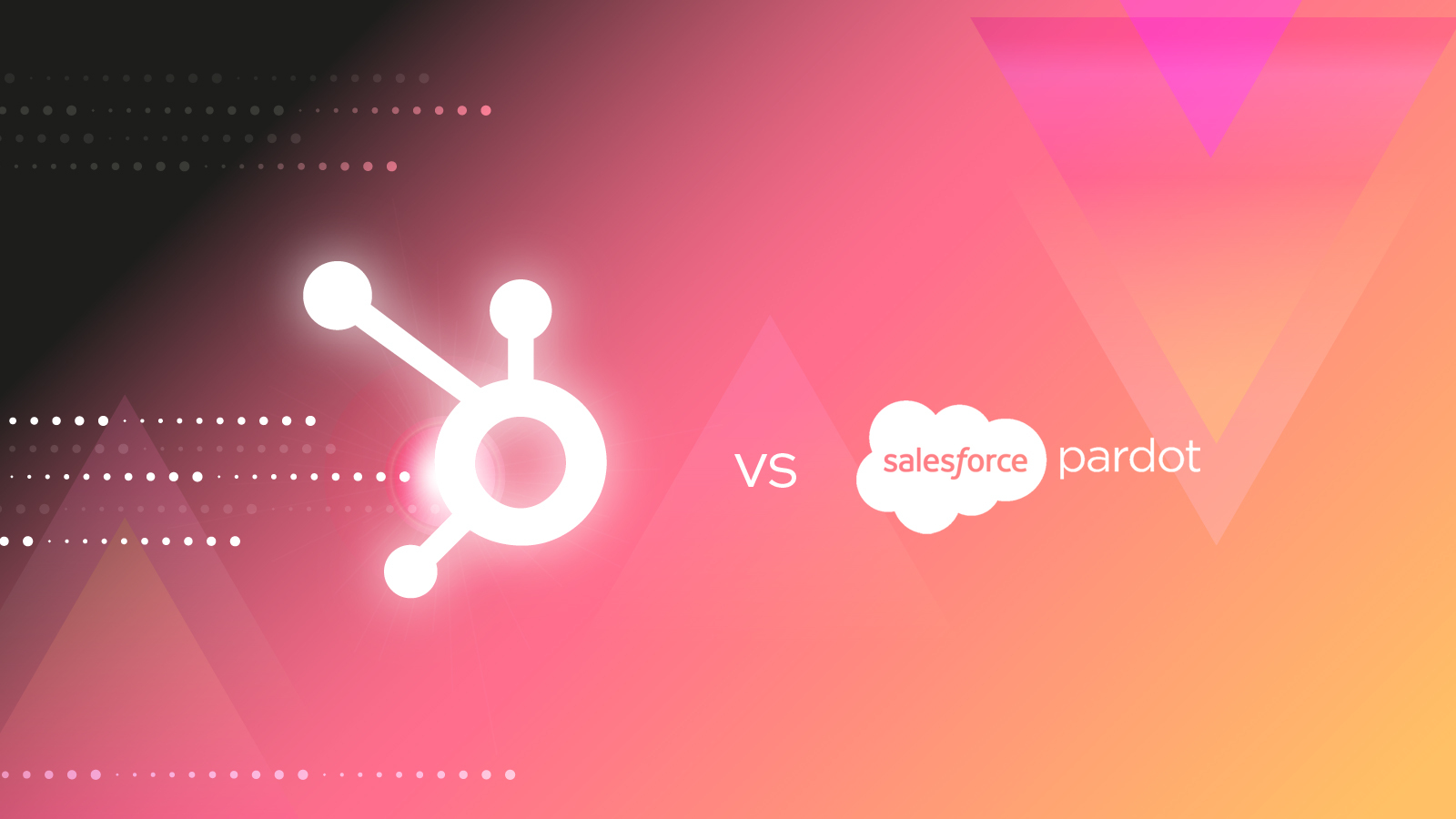Discover why HubSpot is the superior choice for your business over Pardot. From its all-in-one platform to its agency partners, learn how HubSpot can help you achieve your marketing goals.
In the world of marketing automation, choosing the right platform is crucial for the success of your marketing strategy -but today there are so many solutions available it can be difficult to decide which is best for your business.
Two of the most popular options are HubSpot and Pardot, a marketing automation platform by Salesforce that is also known as Marketing Cloud Account Engagement. Both platforms offer a wide range of features and capabilities, but they also have some key differences that you need to know about when choosing a platform.
In this blog post, we will take a comprehensive look at both HubSpot and Pardot, comparing their features, pricing, and overall suitability for different types of businesses. As Diamond HubSpot Partners, we believe that HubSpot will be the optimum solution for many businesses - however, you understand your organisation better than anyone. Keep reading to get all the information you need to make a well-informed decision.
Pardot vs HubSpot: which is best for your business?
HubSpot is likely to be the ideal marketing automation solution for your business if you are looking for…
1. An all-in-one platform
First and foremost, HubSpot offers a complete marketing, sales, and service platform, whereas Pardot is focused solely on marketing automation. This means that with HubSpot, you have access to a wider range of tools and features to help you streamline and automate your entire sales and marketing process.
HubSpot therefore eliminates the need for your business to invest in and integrate multiple different tools and platforms, which can be time-consuming and confusing. It can also save your team time and free them up to focus on more strategic tasks, as it streamlines workflows so they can work more efficiently and effectively.
The platform includes a wide range of features and tools, including email marketing, social media marketing, landing pages and forms, lead management, a CRM, sales automation, and customer service. This gives you a complete view of your customers and all of your team’s interactions with them, from the first time they engage with your business to the time they become a customer and beyond.
HubSpot is also designed to be scalable, which means you can start with the basic features and add more functionality as your needs grow or change. Additionally, HubSpot offers integrations with a wide range of third-party tools and platforms, so that you can easily connect your existing systems and workflows.
Pardot, on the other hand, was originally a standalone platform before it was bought by Salesforce in 2013. Pardot - or Marketing Cloud Account Engagement, as it’s now known - does connect with Salesforce’s applications for sales, service, and marketing. However, it’s not as seamless as HubSpot, because it requires manual connections and maintenance to create a unified user experience. This also adds to Pardot’s technical complexity, which means you’ll need to have an expert in-house or seek support from external experts in integrating the different applications.
2. Intuitive and user-friendly interface
One of the biggest advantages of HubSpot is its intuitive and user-friendly interface. The platform is designed to be easy to navigate, even for users with little to no technical experience. This means your teams will be able to quickly get up and running with marketing automation through HubSpot, without having to invest in expensive training or consulting services.
Another advantage of HubSpot’s interface is its customisation capabilities. HubSpot allows you to personalise your dashboards and workspaces, so that you can view and access the information that is most important to your team. This can include custom reports, charts, and other data visualisations, as well as shortcuts to frequently used tools and features. This way, you can track the metrics that are most important to your business.
Additionally, the interface is designed with collaboration in mind. HubSpot allows multiple users to access and work on the platform simultaneously, making it easy for your teams to share information and collaborate on projects. The platform also includes tools for communication, such as the ability to assign tasks, leave comments, and create to-do lists, making it easy for everyone to stay on track and meet their goals.
While Pardot is also fairly easy to use, you will need access to experienced and well-trained administrators to implement and maintain the platform. Most Salesforce customers therefore rely on the support of a consulting agency or find that they need to hire a full-time Pardot admin, neither of which is a cheap option. So if you’re looking for a CRM that you don’t need coding experience to customise, it’s best to opt for HubSpot.
3. Advanced features
In terms of features, HubSpot offers a wide range of capabilities that can help businesses of all sizes to improve their marketing and sales efforts. Some of the key features that set HubSpot apart from Pardot include its advanced analytics and reporting capabilities, which allow businesses to track and measure the effectiveness of their campaigns in real-time.
HubSpot also offers a wide range of features and tools that make it easier for you to deliver marketing campaigns that get results. HubSpot's email marketing tool, for example, enables you to create, send, and track email campaigns, all within the platform. The drag-and-drop email builder is really simple to use and gives you a number of templates and designs to choose from, so you can create professional-looking emails in minutes.
And HubSpot's landing pages and forms tool allows your marketing team to create custom landing pages and forms that are completely optimised for conversion. It also enables you to A/B test different design and copy configurations, so you can optimise your website and maximise your leads.
Compared to HubSpot, Pardot is much more focused on email automation, which means you’ll probably find that you need to connect more tools as you scale your marketing. Pardot does support lead generation with tools like landing pages, workflows and A/B testing. But landing pages, for example, are typically hosted on a subdomain or a third-party domain that’s separate from your website. That’s not ideal for your site’s SEO, and although tracking across domains is possible, it’s much trickier than with HubSpot.
4. An integrated solution
It’s also easy to integrate HubSpot with other popular tools and platforms, such as Salesforce, Google Analytics, and more, so you can connect and share data with other systems.
For example, HubSpot integrates with Google, one of the largest and most popular cloud-based platforms. This integration allows your teams to connect their Google email, calendar, and contacts with HubSpot, as well as access a range of Google tools, such as Google Analytics and Google AdWords.
HubSpot also integrates with Zendesk, one of the most popular customer service platforms. With Zendesk and HubSpot fully integrated, you’ll find it much easier to manager your customer support and service operations, as well as track and report on your customer interactions and feedback.
Pardot also integrates with a range of other applications, such as Unbounce, Salesforce and GoToWebinar. However, many customers find that it’s more complex to connect these applications and require admin and developer support, so you may find it’s more difficult to change and adapt your Pardot instance over time.
5. Pricing model
Unlike Pardot, which charges on a per-user basis, HubSpot offers a tiered pricing model that is based on the number of contacts in your database. This means that you can start with a lower-priced plan and upgrade as your business’s needs grow, without having to worry about overspending on unnecessary features.
HubSpot's pricing plans are designed to accommodate businesses of all sizes, from small start-ups to large enterprises. The platform offers a range of pricing options, including a free CRM, a free marketing plan, and a range of paid plans that offer increasing levels of functionality. This means you can choose the plan that best fits your organisation’s budget and needs.
Another advantage of HubSpot's pricing model is its transparency. The platform clearly outlines the features and capabilities included in each plan, making it easy to compare options and choose a plan within your budget. HubSpot's pricing plans are month-to-month and can be updated at any time, giving you the flexibility to adjust your plan whenever you need to.
Pardot not only prices differently to HubSpot (based on number of users rather than number of contacts), it’s also more expensive than HubSpot across all pricing tiers. The price you will pay isn’t immediately obvious, either - you have to call a Salesforce representative to get a quote for Pardot, whereas with HubSpot you can see your price and pay with a credit card on their website. If your business has 10,000 contacts and 10 users, however, you can expect to pay $80,600 in the first year of implementing Pardot compared to just $49,200 for HubSpot.
6. Customer support
In terms of customer support, HubSpot offers a range of resources and support options to you get the most out of the platform. From a comprehensive knowledge base to live training and support, HubSpot offers a comprehensive and responsive customer support experience.
Some of the key features and benefits of the customer support offering include a Help Centre which gives you access to a range of educational resources, such as articles, videos, and tutorials. The Help Centre is designed to be easy to use and navigate, so you can quickly find the information you need to master HubSpot.
Crucially, if you choose HubSpot over Pardot you can also access another level of support from HubSpot’s agency partners. HubSpot has a network of certified agency partners that can provide you with support with everything from onboarding your teams onto HubSpot to marketing strategy execution and training.
A Diamond HubSpot Agency Partner - like Cognition CRM - will have an in-depth knowledge of the platform and can help businesses like yours to develop and implement effective marketing strategies that are tailored to their specific needs.
When it comes to Pardot, however, support comes at a price. If you want to access 24/7 premier support, Pardot charges an extra 20% of your net contract price this support, while additional feature access costs 30% of your net contract price. As product and feature support is a necessity for Pardot implementation and maintenance, it’s important to factor these support costs into your calculations.
Ready to get started with HubSpot?
Overall, while both Pardot and HubSpot are powerful marketing automation platforms, we believe if you want the best on the market, HubSpot is the better choice for the vast majority of businesses.
With its complete, all-in-one platform, intuitive interface, advanced analytics and reporting capabilities, extensive integrations, and flexible pricing model, HubSpot offers a wide range of features and capabilities that can help businesses to streamline and automate their sales and marketing efforts. Furthermore, HubSpot's comprehensive customer and partner channel support and resources makes it easier for businesses to get the most out of the platform.
If you’re interested in finding out how HubSpot could benefit your business, get in touch with our team today.


